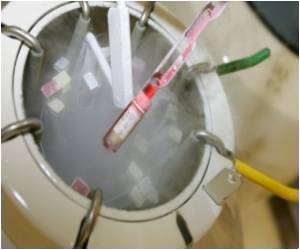Study says use of ovarian tissue cryopreservation may not be safe for women suffering from leukemia

"Our study provides clear evidence that cancer cells in women with acute and chronic leukemias can contaminate the ovaries," said Marie-Madeleine Dolmans, MD, professor at the Université Catholique de Louvain in Brussels and lead author of the study. "If this tissue is reimplanted in these women when they're ready to have children, there's a good possibility that the cancer will come back."
As most acute lymphoblastic leukemia (ALL) patients are diagnosed with the disease at a young age, consideration of the preservation of their fertility is especially important. In fact, according to the National Cancer Institute, 71 percent of those diagnosed with ALL are less than 35 years old, as are nearly 10 percent of those with chronic myelogenous leukemia (CML)1. In 2010, it is estimated that 2,180 women will be diagnosed with ALL and 2,070 with CML1.
As aggressive chemotherapy and radiotherapy are damaging to the reproductive organs, the researchers wanted to examine the safety of using ovarian tissue cryopreservation to safeguard the fertility of patients with leukemia. In this study, researchers examined the implications of the technique in 12 women with ALL, a fast-growing cancer of the white blood cells, and six women with CML, a slowly progressing bone marrow cancer. The 18 patients included in this study were between 2 and 31 years of age when their ovarian tissue was cryopreserved (from 1999 to 2008). The mean age of the patients with ALL was 14.5 years and 24.7 years for those with CML.
Although initial microscopic examination did not reveal any cancerous cells in the ovarian tissue samples collected from each patient, by using a technique called real-time quantitative polymerase chain reaction (RT-qPCR), the scientists found cancerous cells in the ovarian tissue of 70 percent of the ALL patients and 33 percent of the CML patients. For further analysis, the researchers engrafted the ovarian tissue samples into 18 healthy mice for an observational period of six months. In the mice who received tissue from CML patients, the grafts looked normal and did not appear to contain any cancerous cells. In contrast, four of the mice who received ovarian tissue from ALL patients developed tumors. Through use of RT-qPCR and the mouse model, the researchers demonstrated the viability and malignant potential of leukemic cells present in the frozen ovarian tissue, especially from ALL patients.
"Given our findings, further research is needed to develop safer options for fertility preservation in patients with acute and chronic leukemias," said Jacques Donnez, MD, professor at the Université Catholique de Louvain in Brussels and co-author of the study.
Advertisement
Advertisement














